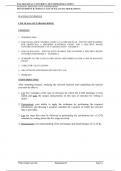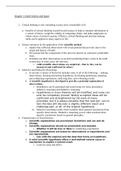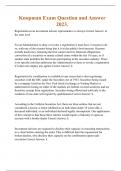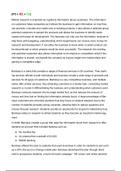WALTER SISULU UNIVERSITY: BUTTERWORTH CAMPUS
NATIONAL DIPLOMA: CIVIL ENGINEERING
MANAGEMENT II: MODULE 5: LINE OF BALANCING PROGRAMMING
PLANNING TECHNIQUES
LINE OF BALANCE PROGRAMMING
CONTENTS
1. INTRODUCTION
2. LINE OF BALANCE CONTROL CHART AT A CERTAIN DATE – STEP BY STEP EXAMPLE
FOR PRODUCING A PROGRESS (CONTROL) CHART FOR A MULTIPLE HOUSE
CONSTRUCTION PROJECT AT A CERTAIN DATE – EXAMPLE 1
3. LINE OF BALANCE – STEP BY STEP EXAMPLE FOR PLANNING A MULTIPLE HOUSE
CONSTRUCTION PROJECT – EXAMPLE 2
4. SUMMARY OF THE CALCULATION STEPS AND FORMULAS FOR A LINE OF BALANCE
CHART
5. TABLE FOR CALCULATIONS
6. ADVANTAGES AND DISADVANTAGES OF L.O.B
7. PROBLEM 1
STUDY OBJECTIVES
After attending lectures, studying the relevant material and completing the tutorial
you must be able to:
1. List five examples of the type of structure for which the L.O.B technique is best
suited and state the unique characteristic of this type of structure by writing it
down.
2. Demonstrate your ability to apply the technique by performing the required
calculations and drawing a program schedule for a project of which the relevant
data is provided.
3. List the steps that must be followed in performing the calculations for a L.O.B
schedule by writing down the five steps involved.
4. Demonstrate your understanding of the advantages and disadvantages of a L.O.B.
Walter Sisulu University Management II Page 5.1
,WALTER SISULU UNIVERSITY: BUTTERWORTH CAMPUS
NATIONAL DIPLOMA: CIVIL ENGINEERING
MANAGEMENT II: MODULE 5: LINE OF BALANCING PROGRAMMING
INTRODUCTION
In construction there are some projects in which a predominant feature is that of
repetition. The following are typical examples:
1. Housing development contract
2. (a) Piling contract
(b) Capping piles
3. A block of flats/ Hostel
4. A hotel with a series of identical rooms
5. School Building – Classrooms
6. Gabions retaining walls
For such work it is extravagant, as well as difficult, to draw and maintain critical path
networks illustrating the detail of the construction process for each of the units
involved. The updating of such a network and its use as an instrument of control for
the delivery of material and each individual construction operation presents many
problems of organization. The discipline and logic of networks can, however, be
employed in a more rational way for such projects by using the line-of-balance
method
The line-of-balance method is based upon the establishment of a required delivery
programme for completed units. From this programme requirement and the
dependency and relationship of foregoing activities on it, a schedule can be prepared
for the delivery, manufacture or construction of the various parts which to make up
the whole.
LINE OF BALANCE – STEP BY STEP EXAMPLE FOR PLANNING A MULTIPLE HOUSE
CONSTRUCTION PROJECT
Line of balance chart for a project:
A project consisting of 120 similar houses will require a handover rate of 6 houses per
week. The contractor will be working a five day week at 42 hours per week, and
taking holidays etc, into account decides to base his programme on a total of 300
working days.
Operation Man-hours Men per activity per
Per unit per activity unit (teams)
M
H
Foundations 100 3
Brickwork 220 6
Window frames 50 1
Roof 200 4
Plumbing 150 3
Plaster 40 3
Joinery 120 4
Electrician 90 3
Decorates 130 4
Clean up 20 2
Walter Sisulu University Management II Page 5.2
, WALTER SISULU UNIVERSITY: BUTTERWORTH CAMPUS
NATIONAL DIPLOMA: CIVIL ENGINEERING
MANAGEMENT II: MODULE 5: LINE OF BALANCING PROGRAMMING
Step 1
The first step is to calculate the total theoretical number of men – G – required to
complete the required units per week – for each activity. (Units per week - R) We
have the following information: we require 6 units per week and we have available
42 hours per week. Therefore we must complete 6/42 units per week. Therefore we
must complete 6/42 units per hour on each activity, but we have a certain given man-
hours per house – M - which is required to complete that activity per unit. From this:
ie
G = Man-hours/house x Number of units required/week
Number of hours/week available
= Theoretical gang size on the activity (Theoretical number of men on the
activity on the project as a whole)
To calculate the number of labourers needed in our gang
G= M x number of units required/week
number of hours/week available
where: G is the theoretical gang size and M is Man-hrs. per unit
M = Man-hours/house
For example take the operation: Foundations: from the given table below, 100 man-
hours per unit is required, thus M = 100.
Thus G (Gang size) = M X 6/42
= 100 x (6/42)
= 14.29 men
Therefore: the Gang size (Total number of men per activity per project) required is
14.29 men.
Operation Man-hours Men per House Gang size
Per house
M H G
Foundations 100 3 14,29
Brickwork 220 6 31.43
Window frames 50 1 7.14
Roof 200 4 28.57
Plumbing 150 3 21.43
Plastering 40 3 5.71
Joinery 120 4 17.14
Electrician 90 3 12.86
Decorates 130 4 18.57
Clean up 120 2 17.14
Walter Sisulu University Management II Page 5.3
NATIONAL DIPLOMA: CIVIL ENGINEERING
MANAGEMENT II: MODULE 5: LINE OF BALANCING PROGRAMMING
PLANNING TECHNIQUES
LINE OF BALANCE PROGRAMMING
CONTENTS
1. INTRODUCTION
2. LINE OF BALANCE CONTROL CHART AT A CERTAIN DATE – STEP BY STEP EXAMPLE
FOR PRODUCING A PROGRESS (CONTROL) CHART FOR A MULTIPLE HOUSE
CONSTRUCTION PROJECT AT A CERTAIN DATE – EXAMPLE 1
3. LINE OF BALANCE – STEP BY STEP EXAMPLE FOR PLANNING A MULTIPLE HOUSE
CONSTRUCTION PROJECT – EXAMPLE 2
4. SUMMARY OF THE CALCULATION STEPS AND FORMULAS FOR A LINE OF BALANCE
CHART
5. TABLE FOR CALCULATIONS
6. ADVANTAGES AND DISADVANTAGES OF L.O.B
7. PROBLEM 1
STUDY OBJECTIVES
After attending lectures, studying the relevant material and completing the tutorial
you must be able to:
1. List five examples of the type of structure for which the L.O.B technique is best
suited and state the unique characteristic of this type of structure by writing it
down.
2. Demonstrate your ability to apply the technique by performing the required
calculations and drawing a program schedule for a project of which the relevant
data is provided.
3. List the steps that must be followed in performing the calculations for a L.O.B
schedule by writing down the five steps involved.
4. Demonstrate your understanding of the advantages and disadvantages of a L.O.B.
Walter Sisulu University Management II Page 5.1
,WALTER SISULU UNIVERSITY: BUTTERWORTH CAMPUS
NATIONAL DIPLOMA: CIVIL ENGINEERING
MANAGEMENT II: MODULE 5: LINE OF BALANCING PROGRAMMING
INTRODUCTION
In construction there are some projects in which a predominant feature is that of
repetition. The following are typical examples:
1. Housing development contract
2. (a) Piling contract
(b) Capping piles
3. A block of flats/ Hostel
4. A hotel with a series of identical rooms
5. School Building – Classrooms
6. Gabions retaining walls
For such work it is extravagant, as well as difficult, to draw and maintain critical path
networks illustrating the detail of the construction process for each of the units
involved. The updating of such a network and its use as an instrument of control for
the delivery of material and each individual construction operation presents many
problems of organization. The discipline and logic of networks can, however, be
employed in a more rational way for such projects by using the line-of-balance
method
The line-of-balance method is based upon the establishment of a required delivery
programme for completed units. From this programme requirement and the
dependency and relationship of foregoing activities on it, a schedule can be prepared
for the delivery, manufacture or construction of the various parts which to make up
the whole.
LINE OF BALANCE – STEP BY STEP EXAMPLE FOR PLANNING A MULTIPLE HOUSE
CONSTRUCTION PROJECT
Line of balance chart for a project:
A project consisting of 120 similar houses will require a handover rate of 6 houses per
week. The contractor will be working a five day week at 42 hours per week, and
taking holidays etc, into account decides to base his programme on a total of 300
working days.
Operation Man-hours Men per activity per
Per unit per activity unit (teams)
M
H
Foundations 100 3
Brickwork 220 6
Window frames 50 1
Roof 200 4
Plumbing 150 3
Plaster 40 3
Joinery 120 4
Electrician 90 3
Decorates 130 4
Clean up 20 2
Walter Sisulu University Management II Page 5.2
, WALTER SISULU UNIVERSITY: BUTTERWORTH CAMPUS
NATIONAL DIPLOMA: CIVIL ENGINEERING
MANAGEMENT II: MODULE 5: LINE OF BALANCING PROGRAMMING
Step 1
The first step is to calculate the total theoretical number of men – G – required to
complete the required units per week – for each activity. (Units per week - R) We
have the following information: we require 6 units per week and we have available
42 hours per week. Therefore we must complete 6/42 units per week. Therefore we
must complete 6/42 units per hour on each activity, but we have a certain given man-
hours per house – M - which is required to complete that activity per unit. From this:
ie
G = Man-hours/house x Number of units required/week
Number of hours/week available
= Theoretical gang size on the activity (Theoretical number of men on the
activity on the project as a whole)
To calculate the number of labourers needed in our gang
G= M x number of units required/week
number of hours/week available
where: G is the theoretical gang size and M is Man-hrs. per unit
M = Man-hours/house
For example take the operation: Foundations: from the given table below, 100 man-
hours per unit is required, thus M = 100.
Thus G (Gang size) = M X 6/42
= 100 x (6/42)
= 14.29 men
Therefore: the Gang size (Total number of men per activity per project) required is
14.29 men.
Operation Man-hours Men per House Gang size
Per house
M H G
Foundations 100 3 14,29
Brickwork 220 6 31.43
Window frames 50 1 7.14
Roof 200 4 28.57
Plumbing 150 3 21.43
Plastering 40 3 5.71
Joinery 120 4 17.14
Electrician 90 3 12.86
Decorates 130 4 18.57
Clean up 120 2 17.14
Walter Sisulu University Management II Page 5.3











